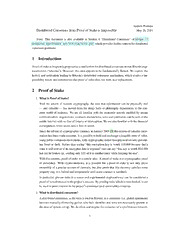Table Of ContentAndrewPoelstra
DistributedConsensusfromProofofStakeisImpossible May28,2014
Note: This document is also available in Section 6 “Distributed Consensus” of https://
download.wpsoftware.net/bitcoin/alts.pdf,whichprovidesfurthercontextfordistributed
consensusproblems.
1 Introduction
Proof-of-stakeisfrequentlyproposedasamechanismfordistributedconsensusinnon-Bitcoincryp-
tocurrencies(“altcoins”). However, thisideaappearstobefundamentallyflawed. Weexplorethe
historyandmotivationleadingtoBitcoin’sdistributedconsensusmechanism, whichevadesaim-
possibilityresult,anddemonstratethatproofofstakedoesnotworkasareplacement.
2 Proof of Stake
1. WhatisProofofStake?
With the advent of modern cryptography, the idea that information can be physically real
— and valuable — has moved from the dingy halls of philosophy departments to the con-
crete world of business. We are all familiar with the economic activity enabled by secure
communication:negotiations,contracts,transactions,salesandcommandscanbesentonthe
publicInternetwithnofearofforgeryorinterception. Wearealsofamiliarwiththefinancial
consequenceswhensecretdataislostorstolen.
SincetheadventofcryptographiccurrencyinJanuary2009[3]thisnotionofvaluableinfor-
mationhasbeenmadeconcrete. Itispossibletoholdandexchangeafungiblestoreofvalue,
usingpubliccommunicationmedia,withcryptographicratherthanphysicalsecurityprevent-
ing fraud or theft. Rather than saying “this encryption key is worth $10,000 because that’s
whatitwillcostusifitsencrypteddataisexposed”onecansay“thiskeyisworth$10,000
butcanbebrokenup,sendingonly$20ofittoanotherpartywhilekeepingtherest”.
Withthiscontext,proof-of-stakeisasimpleidea. Aproofofstakeisacryptographicproof
of ownership. With cryptocurrencies, it is possible for a proof-of-stake to not only prove
ownership of a precise amount of currency, but also prove that this currency satisfies some
property(say,itislockedandunspendableuntilsomecontractissatisfied).
Inparticular, provenstakeinascarceandexperimentalcryptocurrencycanbeconsidereda
proofofvestedinterestintheproject’ssuccess. Byprovingstakewhichistime-locked,itcan
beusedtoproveinterestintheproject’scontinued(andsustainable)existence.
2. Whatisdistributedconsensus?
Adistributedconsensus,asthetermisusedinBitcoin,isaconsensus(i.e. globalagreement)
betweenmutually-distrustingpartieswholackidentitiesandwerenotnecessarilypresentat
thetimeofsystemsetup. Wedoallowandrequiretheexistenceofasynchronousnetwork,
1
i.e.anetworkinwhichallvaliddatareachesallpartiesinareasonableamountoftime.Wedo
not(andcannot,inanuntrustedandphysicallydispersednetwork)assumethatnodesagree
ontheprecisetimingoreventime-orderingofmessagesonthenetwork.
For the purposes of cryptocurrency, it is sufficient to achieve distributed consensus on the
time-orderingoftransactions(andnothingelse). Thisimpliesconsensusonthe“firsttrans-
action which moves these particular funds”, which assures the funds’ new owner that the
networkrecognizesthemassuch.
Thereasonthatthisconsensusisneedediscalledthedouble-spendingproblem. Thatis, in
any decentralized digital currency scheme there is the possibility that a spender might send
thesamemoneytotwodifferentpeople,andbothspendswouldappeartobevalid.Recipients
therefore need a way to be assured that there are no conflicts, or that if there are conflicts,
thatthenetworkwillrecognizetheirversionasthecorrectone. Adistributedconsensuson
transactionorderingachievesthis:inthecaseofconflict,everyoneagreesthatthetransaction
whichcamefirstisvalidwhileallothersarenot.
(Theotherproblemswithdigitalcurrency,e.g. authenticationandpreventionofforgery,are
comparativelyeasyandcanbehandledwithtraditionalcryptography.)
3. HowdoesBitcoinachievedistributedconsensus?
It can be mathematically proven that given only a synchronous network it is impossible to
achievedistributedconsensusinacryptographicallyguaranteedway[1].Bitcoinachievesthe
impossiblebyweakeningitsrequirementfromcryptographicguaranteetoamereeconomic
one. That is, it introduces an opportunity cost from outside of the system (expenditure on
computing time and energy) and provides rewards within the system, but only if consensus
onanunbrokentransactionhistoryismaintained.
To accomplish this, Bitcoin provides a way to prove, for each candidate history, (a) that
opportunitycostwasforfeited,and(b)howmuch. Thisisaso-calledproof-of-work. Further-
more,theworkprovenincludesthatofallparticipantswhoworkedonthehistory1 [2]. The
consensushistoryistheonewithmosttotalwork(atleastasfarasithaspropagatedthrough
the network — our weak synchronicity requirement means that the consensus on the most
recentpartofthehistoryisuncertain). Sincetheconsensushistoryistheonlyonecontaining
spendable rewards for work done, this means (a) that provers have an incentive to work on
the same history that other provers are, and (b) individual provers can’t take control of the
historybecausetheyneedtheirpeers’contribution.
4. Howisproofofstakeusedtoachievedistributedconsensus?
Essentially, the idea behind using proof-of-stake as a consensus mechanism is to move the
opportunitycostsfromoutsidethesystemtoinsidethesystem. Themotivationforthisisthat
using“mostprovenwork”asacriteriaforconsensuscreatesaneconomicincentivetoprove
as much work as possible. For Bitcoin, which proves thermodynamic work (i.e. a certain
1In particular, the work done even by miners who don’t find blocks is included, in exactly the same sense that gas
moleculesinaboxcontributetoitsambienttemperatureeveniftheydon’thappentocollidewiththethermometerduring
measurement.Thisisnotananalogy.Theprinciplesarethesame.
2
amountofirreversiblecomputationwasdone),thereisaphysicallimit—theLandauerlimit
— which controls what “as much work as possible” means2. The result of this limit is a
consensus which is extremely resource-intensive, producing entropy and driving us toward
theheatdeathoftheuniverseliterallyasfastasthelawsofphysicswillallow3. Bymoving
theopportunitycostsintoahuman-designedcryptocurrency,itshouldbepossibletoconstruct
lawswhichforcemuchsmallerlimitsonresourceconsumption.
Onalowerlevel,thewaythatproofofstakeworksisthatcurrencyholdersareabletolock
theircurrencyforsomeamountoftime,renting“stake”whichiscryptographicallyverifiable.
Thentoextendtheconsensushistory,ratherthanattachingaproofofwork,eachstakeholder
digitallysignstheextension.Forreasonsofpracticality,typicallyasmallrandomselectionof
stakeholdersischosenforeachextension,andonlyamajorityoftheselectionarerequiredto
givetheextensionvalidity. Thechosenstakeholdersaregivenarewardandaftersometime
theyareabletounlocktheirstakeiftheysodesire.
Theideaisthatratherthandependingontheeconomicinviabilityoftakingcontrolofahis-
tory,stakeholdersareincentivizedtoagreeoneachextensionbecause(a)theyarerandomly
chosen and therefore unlikely to be in collusion, and (b) even if they can collude, they do
notwanttounderminethesystem(e.g. bysigningmanyconflictinghistories)becausethey
wanttorecovertheirstoredvaluewhentheirstakecomesunlocked,and(c)theyhavelimited
capacity to cause havoc anyway, since for the above reasons the next random selection of
stakeholderswillprobablychooseonlyasinglereasonablehistorytoextend.
5. Whatiswrongwiththismechanismforconsensus?
On a high level, by tying our stake to (temporarily) sacrificed cryptographic resources, we
are begging the question of consensus on who is in possession of what resources. Proof of
stakeadvocatesattempttoevadethisaccusationbypointingoutthatfalsehistoriescanonly
be created by stakeholders, and their power is limited to a short interval of time (the time
whentheyarethechosensigners)duringwhichtheyareincentivizednottodoso. Therefore
conflictinghistoriessimplywillnotappear,andwecanappealtosynchronicityofthenetwork
toobtainconsensusontheoneexistinghistory.
Theproblemwiththisargumentissimple: the“shortintervaloftime”isonlyshortasmea-
suredbytheconsensushistory,whichonlycorrespondstoashortintervalinrealtimeifthere
existsaconsensushistory. Sowearestillbeggingthequestion. Infact,ifastakeholderlater
irreversiblysellshisstakeforsomeresourceoutsidethesystem(e.g. atanexchange),heno
longerhasincentivenottoforkthehistory(orworse,exposehiskeysandletothersforkthe
2Thisiswhyweconsidertheproofofworktobea“proof”,bytheway:aslongasourhashfunctionisstrong,thelaws
ofphysicspreventcheating.
3As an aside, it is interesting to note that rather than using a proof-of-work limited by the thermodynamic limit of
computations per second, it should be possible to construct a proof-of-work which is limited by the bandwidth of the
universe,i.e.,theuncertaintyprinciplewhichputsalowerboundonthesizeofinformationstoragealongwiththespeedof
lightwhichputsboundonhowfastinformationcantravelfromstoragetostorage.Sinceinformationtransferisreversible,
theresultantproofofworkshouldrequirelargeamountsofentropyproduction.Thisisthepremisebehindamemory-hard
proof-of-work,whichisoutsidethescopeofthisarticle.Seeforexample[4].Therearemanysubtletiestothisbutthemain
concernwithsuchaproof-of-workisthatitshiftsprovingcostsfrommarginalexpensestocapitalones,whichforacurrency
maycauseeconomicincentivestowardanoligarchy.
3
history)atthepointinconsensustimewhenhehadcontrol.
This is a bit abstruse. We can illustrate it with an example. Suppose that at some early
point in consensus time, a single person has the ability to extend history. (For example,
theyhavecontrolovereverykeywhichanewblockisrequiredtobesignedby.) Thismay
havehappenedorganically,ifthisperson’skeyswerechosenrandomlybythestake-choosing
algorithm,butitcouldalsohappenifthispersontracksdowntheotherkeyholdersandbuys
their keys. This may happen much later in consensus time (and real time), so there is no
reasontobelievethesekeyholdersarestillincentivizedtokeeptheirkeyssecret. Alternately,
theymayhaverevealedthekeysthroughsomehonestmistake,thechancesofwhichincrease
astimepasses,backupsarelost,etc.
Now,wehaveaconsensushistoryandanattackerwhoisabletoforkitatsomeearlytime.
To actually replace the entire consensus history, he needs to produce an alternate history,
starting from his fork, which is longer than the existing history. But every block needs a
newrandomselectionofsigners,soisthispossible? Theanswerisabsolutelyyes: wehave
beenusingthisword“random”,butinfactwehaverequiredconsensusonthesetofsigners
(otherwise forks would trivially happen), so even a random selection must be seeded from
pastconsensushistory. Therefore,anattackerwithenoughpastsigningkeyscanmodifythe
history he has direct control over, causing future signer selections to always happen in his
favour. (It is likely he needs to “grind” through many choices of block before he finds one
whichletshimkeepcontrolofthesignerselection. Ineffect,hehasreplacedproof-of-stake
withproof-of-work,butacentralizedone.)
Further,thisabilitytocontrolthefutureselectionofstakeholders(andeventhesetofstake-
holders,bycontrollingwhichtransactionsappearinblocks)hasseriousconsequences. This
isbecauseevenwithoutadeliberateattacker,thesignerswhoextendthehistoryateverypoint
haveanincentivetodirectthehistorytowardoneinwhichtheyhavemorestake(andthere-
foremorereward),whichcausesthesystemtotrendtowardcentralization. Theymaydothis
byskewingthestakeselectionoffutureblocks,ormoreinsidiouslybycensoringtransactions
which(mayeventually)increasethesetofstakeholders.
6. Is it possible to obtain a distributed consensus without provably consuming some re-
sourceoutsideofthesystem?
Intuitively,theanswerisno,butthereisnorigorousargumentforthisclaim.
The problem ultimately comes down to what Greg Maxwell calls costless simulation, and
AndrewMillercallsnothingatstake. Ifitiscostlessforsignerstocreatevalidblocks,then
they are able to cheaply search the blockspace for blocks which direct the history in their
favour. No matter how the network is designed to prevent a minority takeover, an attacker
can direct history toward a present in which they are the majority, as determined by the
consensus,eveniftheyareonlyasinglepartyinphysicalspace.
It would therefore appear that whatever space we want to achieve distributed consensus in
(inBitcoin’scase, itisthespaceofhumans, whichcanweapproximatebythermodynamic
4
spacesinceweareautonomousagentswithinthatspace), weneedtoconsumeresourcesin
thatspacetogettheconsensus.
3 About this document.
This eventually should be merged into the “Distributed Consensus” section of A Treatise on Alt-
coins, but as that is very unfinished, in the meantime the author is releasing it as a standalone
article.
Because of the interaction between incentive analysis and cryptography, this subject makes
for frequent and mentally-taxing discussions on IRC. The goal of this document is to clarify the
fundamentalsandputthesediscussionsonsounderfooting.
References
[1] M.A.Fischer,N.A.Lynch,andM.S.Paterson,Impossibilityofdistributedconsensuswithone
faultyprocess,J.Ass.forComp.Mach.32(1985),no.2,374–382.
[2] A. Miller, E. Shi, A. Juels, B. Parno, and Katz. J., Permacoin: Repurposing bitcoin work for
datapreservation,ProceedingsoftheIEEESymposiumonSecurityandPrivacy,IEEE,2014,
http://cs.umd.edu/~amiller/permacoin.pdf.
[3] S.Nakamoto,Bitcoin: Apeer-to-peerelectroniccashsystem,2009,https://www.bitcoin.
org/bitcoin.pdf.
[4] J. Tromp, Cuckoo cycle: a memory-hard proof-of-work system, https://github.com/
tromp/cuckoo,2014.
5

